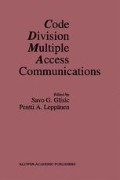Abstract
In this paper, the application of frequency hopping methods to cellular and personal communication systems (PCS) is studied. The performance enhancements due to the use of frequency hopping (FH) is initially reviewed followed by a brief summary of previously designed cellular/PCS systems that have incorporated FH methods. A recently designed slow frequency hop (SFH) prototype which was developed for PCS applications is then described. Performance results using the SFH prototype in laboratory and field trials are provided. These results demonstrate the excellent performance that may be obtained in PCS environments using a SFH architecture which has a complexity level that is suitable for PCS implementation.
Access this chapter
Tax calculation will be finalised at checkout
Purchases are for personal use only
Preview
Unable to display preview. Download preview PDF.
References
Federal Communications Commission, “In the matter of amendment of the Commission’s rules to establish new Personal Communications Services,”Second Report and OrderGEN Docket 90–314, FCC 93451, October 22, 1993; subsequently revised in “Amendment of the Commission’s rules to establish new personal communications services,”Memorandum Opinion and OrderGEN Docket 90–314, FCC 90–314, June 13, 1994.
M. Mizuno, “Randomization effects of errors by frequency-hopping techniques in a fading channel,”IEEE Transactions on Communicationsvol. COM-30, pp. 1052–1056, May 1982.
D. Verhulst, M. Mouly, and J. Szpirglas, “Slow Frequency Hopping Multiple Access for Digital Cellular Radiotelephone,”IEEE Transactions on Vehicular Technologyvol. VT-33, pp. 179–190, August 1984.
G. R. Cooper and R. W. Nettleton, “A spread spectrum technique for high capacity mobile communications,”IEEE Transactions on Vehicular Technologyvol. VT-27, pp. 264–275, November 1978.
P. S. Henry, “Spectrum efficiency of a frequency-hopped-DPSK spread-spectrum mobile radio system,”IEEE Transactions on Vehicular Technologyvol. VT-28, pp. 327–332, November 1979.
D. J. Goodman, P. S. Henry, and V. K. Prabhu, “Frequency-hopped multilevel FSK for mobile radio,”Bell System Technical Journalvol. 59, pp. 1257–1275, September 1980.
G. Einarsson, “Address assignment for a time-frequency-coded, spread-spectrum system,”Bell System Technical Journalvol. 59, pp. 1241–1255, September 1980.
U. Timor, “Improved decoding of frequency-hopped multilevel FSK system,”Bell System Technical Journalvol. 59, pp. 1839–1855, December 1980.
H.-P. Ketterling, “The Digital Mobile Radio Telephone System Proposal S 900 D,”Proceedings of the Second Nordic Seminar on Digital Land Mobile Radio Communicationpp. 126–132, Stockholm, Sweden, October 126–132, 1986.
J. L. Dornstetter and D. Verhulst, “The Digital Cellular SFH 900 System,”Proceedings of the IEEE International Conference on Communicationspp. 36.3.1–36.3.5, June 1986.
European Telecommunications Standards Institute, GSM Specifications, ETSI TC-SMG, Sophia Antipolis, France.
P. D. Rasky, G. M. Chiasson and D. E. Borth, “Hybrid slow frequency-hop/CDMA-TDMA as a solution for high-mobility, wide-area personal communications,”Proceedings of the Fourth Winlab Workshop on Third Generation Wireless Information Networkspp. 199–215, East Brunswick, New Jersey, October 199–215,1993.
P. D. Rasky, G. M. Chiasson, and D. E. Borth, “An experimental slow frequency-hopped personal communication system for the proposed U.S. 1850–1990 MHz band,”Proceedings of the Second International Conference on Universal Personal Communicationspp. 1850–1990, Ottawa, Canada, October 1850–1990, 1993.
W. C. Jakes (ed.)Microwave Mobile CommunicationsNew York: John Wiley & Sons, 1974.
Editor information
Editors and Affiliations
Rights and permissions
Copyright information
© 1995 Springer Science+Business Media Dordrecht
About this chapter
Cite this chapter
Borth, D.E., Rasky, P.D., Chiasson, G.M., Kepler, J.F. (1995). Frequency Hopped Systems for PCS. In: Glisic, S.G., Leppänen, P.A. (eds) Code Division Multiple Access Communications. Springer, Boston, MA. https://doi.org/10.1007/978-1-4615-2251-5_11
Download citation
DOI: https://doi.org/10.1007/978-1-4615-2251-5_11
Publisher Name: Springer, Boston, MA
Print ISBN: 978-1-4613-5948-7
Online ISBN: 978-1-4615-2251-5
eBook Packages: Springer Book Archive

